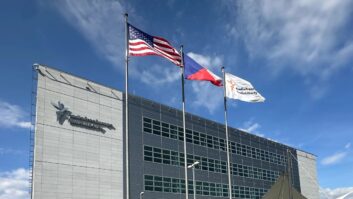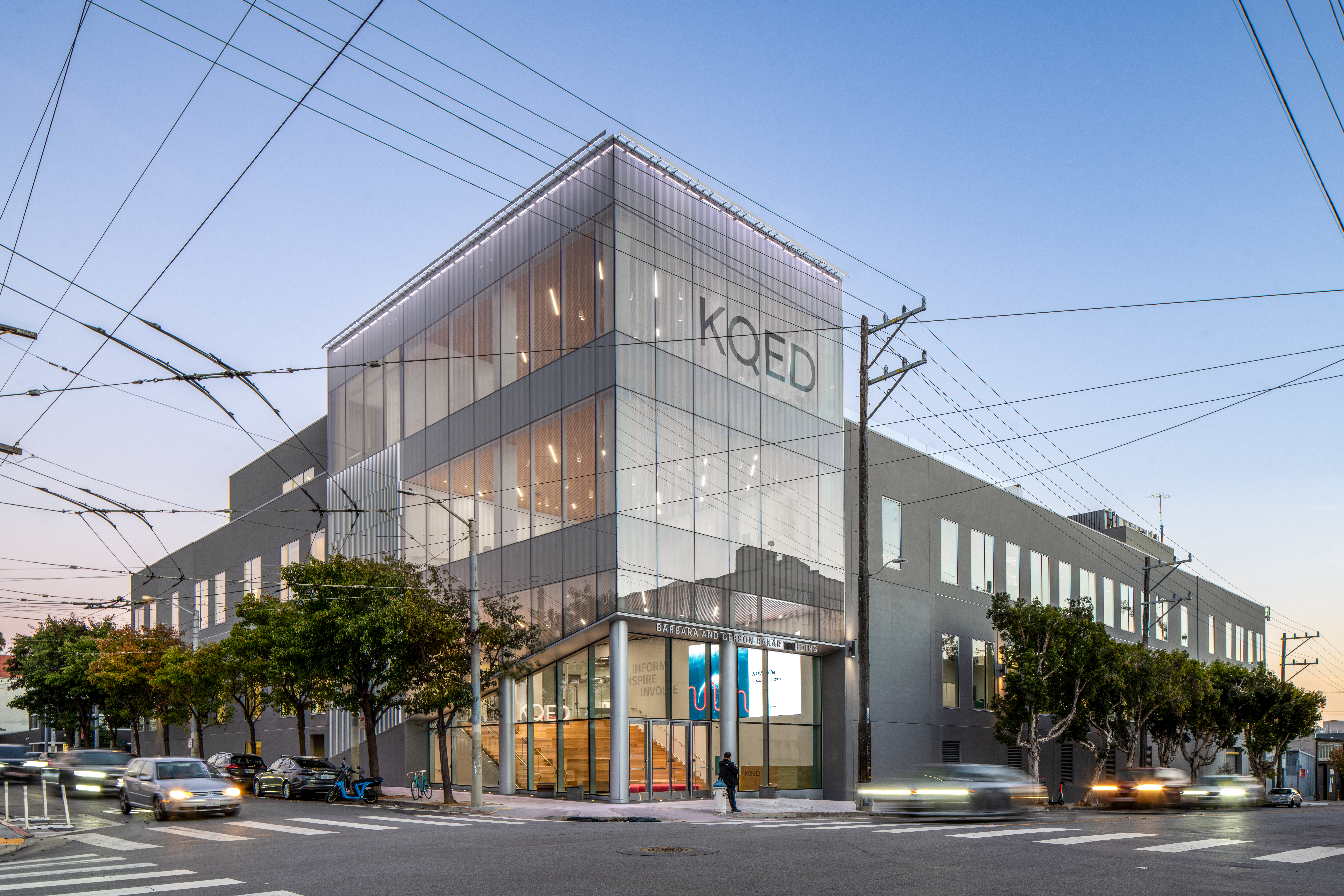Classical Station WCLV(FM) Lives on, and Upgrades Its Facilities to Digital
Detroit doesn’t have a classical music station anymore anymore. Neither does Philadelphia, or San Diego, or Tulsa.
Cleveland could have gone the same way. Its commercial classical station, WCLV(FM), could have been sold for $40 million.
Instead, the station now is run by a nonprofit foundation. Thanks to a complex frequency swap, Beethoven and friends will continue to be heard in Cleveland. As a bonus, a big-band format on AM was saved from oblivion.
The swap in the country’s 25th Arbitron market involved Salem Communications, Clear Channel Communications and a new consortium of nonprofit arts organizations called the WCLV Foundation.
Smack in the middle of it all were the president of WCLV, Robert Conrad, and his partner Rich Marschner, executive vice president and general manager, who initiated the swap and are upgrading their station facilities as part of the project. Conrad and Marschner are the former majority stockholders in Radio Seaway Inc., (WCLV-FM), which is now in the hands of the WCLV Foundation.
Conrad’s involvement with the station goes back to 1962, when he was brought to Cleveland to help convert the former WDGO(FM) to classical.
Even though the AM/FM remains a commercial entity, future profits from the FM will benefit the Cleveland Orchestra, the Cleveland Museum, the Cleveland Institute of Music, the Cleveland Playhouse and the Cleveland Foundation. This is all part of an agreement between the WCLV Foundation and these community organizations.
Conrad and Marschner worked with broker George Reed from Media Services in Jacksonville, Fla., and Washington attorney Patrick Amer of Cleveland law firm Speith, Bell, McCurdy and Newell to navigate these roiling waters.
WCLV(FM) relinquished its 95.5 mHz frequency to Salem Communications in exchange for the frequency and tower site of WHK(AM) at 1420 kHz plus an undisclosed amount of equity in July of 2001. “We got some equity, we got a new AM to play with, and on Nov. 1, 2001, we gave the FM to a non-profit foundation, a gift of $14.5 million,” Conrad said.
The WCLV Foundation received an upgraded Class A at 104.9 from Clear Channel, which in turn received Salem’s 98.1 frequency in nearby Canton, Ohio.
Conrad originally planned to simulcast WCLV(FM) on 1420 AM, but five weeks prior to the closing of this deal in the summer of 2001, Salem also announced it was going to move its WKNR(AM) sports/talk format from 1220 to its WRMR(AM) spot on the dial, 850, thus displacing a big-band station.
Cleveland listeners were upset and wrote letters to the Cleveland Plain Dealer protesting the loss of their favorite music.
WCLV management decided to hire seven members of the soon-to-be-defunct WRMR and purchase the “intellectual property” – the big-band format and some equipment. Thus classical music and big-band standards will be on the air in Cleveland for the foreseeable future.
Musical studios
The addition of an AM studio and other changes necessitated an almost total rebuild for WCLV, one studio at a time. Conrad invited the announcers to participate in planning the new facilities.
“Believe it or not, they wanted stand-up consoles, so (chief engineer) Jerry Goforth had to rip everything out and redesign the rooms,” he said. “The announcers also had input in the placement of the computer screens and other equipment.”
Conrad said the $150,000 budget for the studio rebuild had to take into account the added AM station. Another need was ample space to record and duplicate syndicated shows.
WCLV(FM) offers a number of classical music programs through its Seaway Productions arm including “Adventures in Good Music With Karl Haas,” “The Cleveland Orchestra,” “The Detroit Symphony” and “Milwaukee Symphony Orchestra.” Conrad had to make the most of his facilities to have room to handle duplication and distribution of these shows.
“Before the upgrade we had three production studios, a talk studio and one air studio. We moved the AM station into one of the production control rooms and made a production room out of the talk studio. All five of our studios are in the same building.”
The studios have been converted to digital; the FM air studio was undergoing renovation in September.
Of course nothing goes as smoothly as planned. In this case, Conrad said the former WHK transmitter site had to be upgraded because the ground system was unsuitable and the FM site built by Clear Channel had a few bugs that had to be worked out.
“The AM site is historical,” said Conrad. “It goes back to the 1940s but we had to clean out the equipment left over from several previous regimes. We saved a few things, but most of it went into a dumpster.”
Getting digital
Conrad said the driving force behind the move to digital was the quality of the sound.
“As a classical-music station, we’re interested in the best sound we can produce because we have a very critical audience,” he said. “We occasionally play an archival analog tape and you can really hear the difference compared to CDs.”
But good sound isn’t just necessary on the FM band.
“Our AM format plays a lot of recordings made many years ago,” Conrad said. “But fortunately the technology is there so we can get clean versions of them on CD, and I’m quite pleased with the result.”
Assistant Chief Engineer Randy Davis installed much of the new equipment including Logitek Roc-10 consoles; Logitek vMix Virtual Mixer software, which allows a computer to become another workstation using a 17-inch flat touch screen; ENCO’s DADpro32 delivery system; Harris Intraplex T1 STL; and a satellite dish inherited from the previous owner.
The latter is used to take feeds from the “Wall Street Journal Reports.” Feeds of AP Radio News come from a dish at the studio site, as do various public radio feeds that WCLV(FM) uses, such as the BBC World Service News.
WCLV had been using the recently developed cardioid capacitor AT4047/SV microphone from Audio-Technica for announcing and post-production of the Cleveland Orchestra. The station ordered 12 more of the mics for the digital facility.
The FM control room still has turntables and a reel-to-reel deck for certain classical material not available on CD.
“We use consumer CD players with analog outputs because we found that for the cost of a consumer deck, we don’t mind replacing them every few years,” said Davis. “It’s better than spending $1,000 or more for CD cart machines, which in my experience tend to fail. If one of our CD players goes down, we just go to the store and get another one for $150.”
The AM transmitter is a Gates 5 manufactured by Harris.
The FM air chain uses a CRL DP-100 processor and 5 kW Nautel transmitter. The transmitter site is 27 miles from the studio. The station has two ComStream ABR 700 demods for satellite reception, with StarGuide II and III demods at the AM transmitter site.
The syndication department has two Microboard DSR-8880 CD duplicators with five slaves per unit. With a program loaded into the machine’s hard drive, the operator can run 10 copies at once at 12x.
“We have some people in our traffic department who are very savvy,” said Davis. “A lot of the ad agencies use MP3 files for commercials. That used to be a big pain, but now we have the right software, Internet Explorer and Winamp. Agencies make the spots available on an FTP site where they can be dowloaded by the station.”
For the AM big-band format, the station began with a 9 GB hard drive, but now has upgraded to a 160 GB model.
“The former WRMR had a Scott Studios system (for music storage),” said Davis. “We brought it over and ran it through the inputs of one of our Otari reel-to-reel decks. We’ve been transferring material from the Scott System into the DADpro32, adding music as we go along.
“We wanted to run the DADpro to keep everything simple and uniform from music to traffic. We’re able to combine the logs in DADpro along with (RCS) Selector for the AM music.”
Both WCLV AM and FM are automated to some degree. The DADpro system runs the AM station from 7 p.m. to 6 a.m. The FM primarily runs unattended between midnight and 6 a.m. with “Beethoven Satellite Network,” which originates in Chicago. This program airs in Cleveland on a system designed by Goforth using 25-Hz tones and a relay panel. One of the final steps in the conversion of the stations will be to turn control of that programming over to the DADpro32 system.
IT and IBOC
WCLV recently hired an IT director, Lloyd LiBengood, who had worked there previously on a consulting basis. Goforth had been doing the bulk of the IT work.
With respect to IBOC, Davis said the FM is ready to go.
“But we may need a new AM transmitter,” he said. “The scary part about that is the most recent IBOC AM studies, which show that the service is not recommended for nighttime use. With our nighttime pattern, we lose a few listeners after sundown, but with IBOC it could be a lot worse, in my opinion.”
Asked what he would have done differently in the conversion to digital, Davis had specific ideas.
“I’d start from scratch while keeping the analog systems in place,” he said. “I would rather have done a fresh build.”
Conrad said the team was forced to convert one studio at a time because the decision not to simulcast the classical format on the new AM station came just five weeks before the deal was to be consummated.
Conrad’s radio career spans 55 years with stints in several cities including Chicago, Detroit and Honolulu. But he is most proud of his job at WCLV.
“We could have sold the FM for $40 million and walked away, but we engineered a deal to give the FM to a nonprofit foundation. It’s been a great 40 years.”







